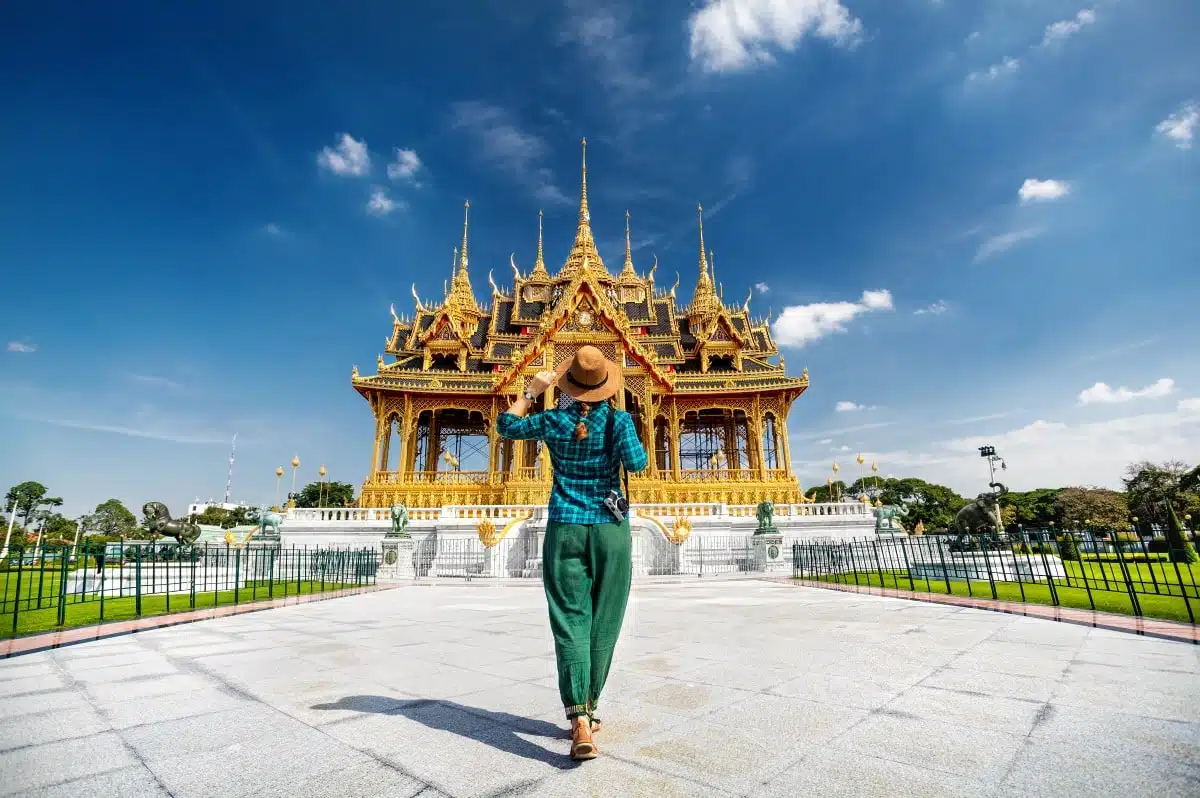Thailand, with its rich cultural heritage, stunning landscapes, and renowned hospitality, offers a plethora of experiences for every traveler. From the bustling streets of Bangkok to the serene beaches of the south and the lush mountains of the north, this guide will take you through the diverse facets of Thailand, ensuring a journey filled with discovery and wonder.
1. Bangkok
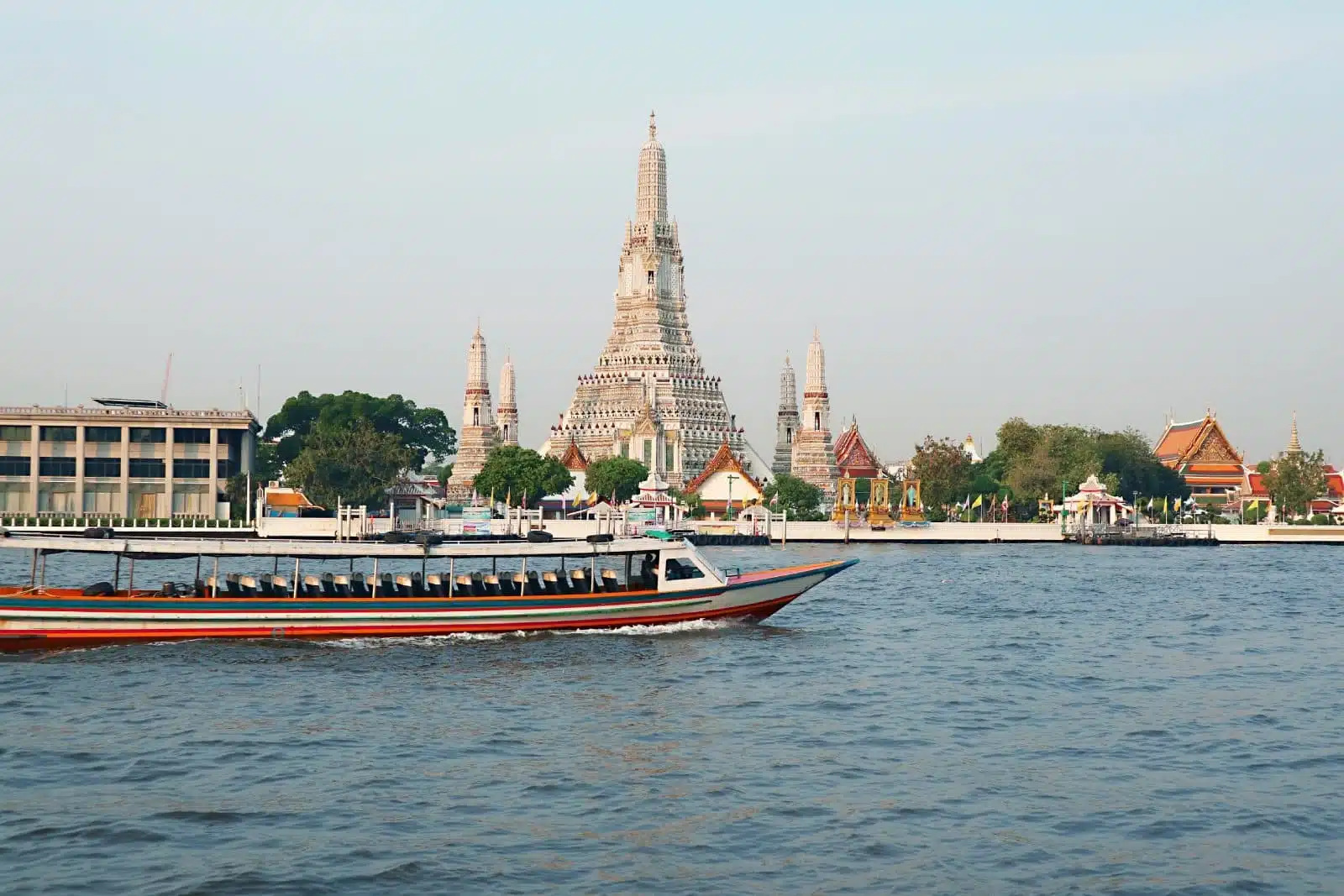
Image Credit: Shutterstock / lovelypeace
Bangkok, a city where ancient traditions seamlessly blend with modernity, offers an experience like no other. As you navigate its bustling streets, you’ll encounter magnificent temples such as Wat Phra Kaew and Wat Arun, standing as serene sanctuaries amidst the urban chaos. The Grand Palace, a former royal residence, highlights the city’s rich history and architectural grandeur. For shopping enthusiasts, the sprawling Chatuchak Weekend Market presents a labyrinth of stalls selling everything from vintage clothing to local handicrafts. Don’t miss the opportunity to indulge in Bangkok’s renowned street food, where dishes like Pad Thai and Som Tam are served with authentic flavors. The city’s vibrant nightlife, from rooftop bars to lively street markets, pulsates with energy, offering a glimpse into the contemporary lifestyle of Bangkok’s residents. Navigating Bangkok explores contrasts, where each turn presents a new facet of this dynamic city.
Insider’s Tip
Visit the lesser-known but equally impressive Wat Benchamabophit for a more tranquil temple experience.
How To Get There
Bangkok is accessible by its two main airports, Suvarnabhumi and Don Mueang. The city has an extensive public transport system, including the BTS Skytrain and MRT.
Best Time To Travel
The cool season from November to February is ideal, with pleasant weather and numerous festivals.
2. Chiang Mai
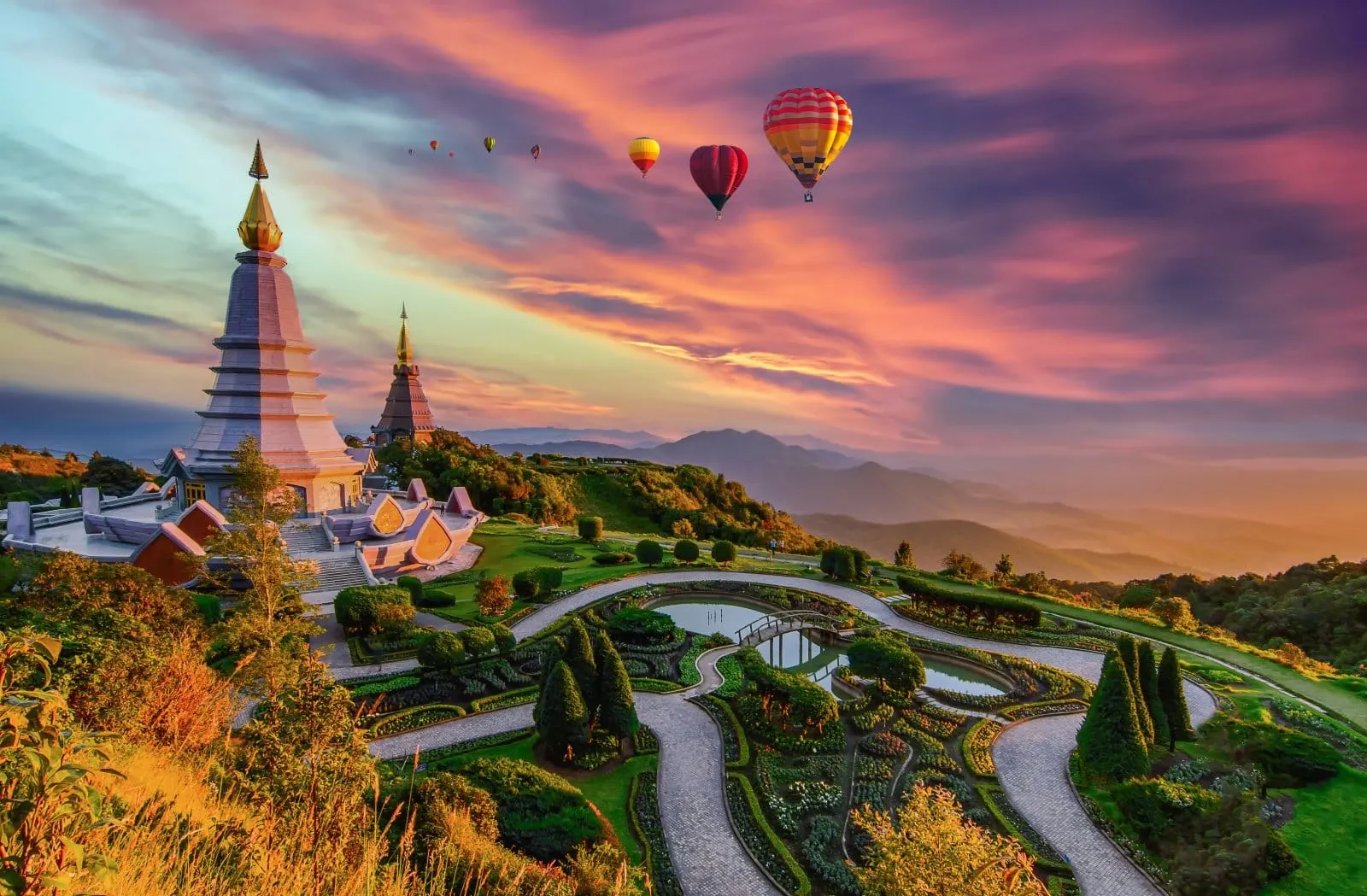
Image Credit: Shutterstock / Take Photo
In Chiang Mai, the cultural heart of Northern Thailand, you’ll find a more laid-back atmosphere than Bangkok’s frenetic energy. The city is replete with historic temples, the most famous being Wat Phra Singh and Wat Chedi Luang, each offering a peaceful retreat and a look into the spiritual practices of the locals. The Night Bazaar and Sunday Walking Street Market are hubs for artisanal crafts and street food, reflecting the city’s artistic flair and culinary richness. Just outside the city, the lush landscapes of Doi Inthanon National Park await, with trekking trails leading to waterfalls and hill tribe villages. Chiang Mai’s charm lies in its blend of history, culture, and nature, providing a holistic experience of Thailand’s northern region. Whether you’re exploring its ancient temples, engaging in a traditional Thai cooking class, or wandering through its vibrant markets, Chiang Mai captivates with its serene beauty and rich cultural tapestry.
Insider’s Tip
Take a Thai cooking class to delve deeper into the region’s unique flavors.
How To Get There
Chiang Mai has an international airport and is also accessible by train or bus from Bangkok.
Best Time To Travel
Visit during the cool season, particularly in November for the Yi Peng Lantern Festival.
3. Phuket
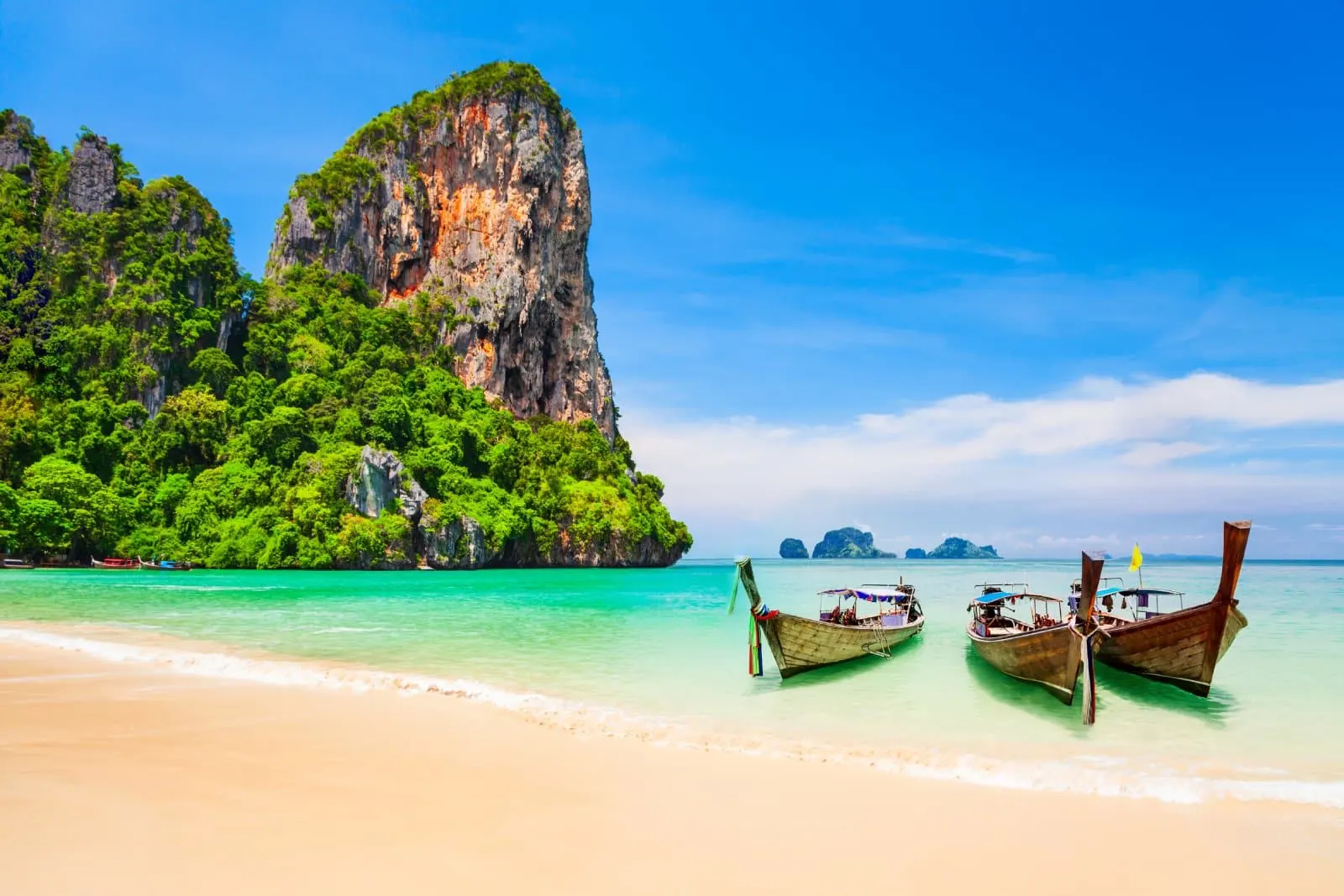
Image Credit: Shutterstock / saiko3p
Phuket, Thailand’s largest island, is a blend of experiences catering to those seeking relaxation and adventure. The island’s beaches, like Patong, Kata, and Karon, offer a range of atmospheres, from bustling shores with water sports activities to more tranquil retreats. Beyond its stunning beaches, Phuket’s Old Town reveals a different side of the island, with Sino-Portuguese architecture and a burgeoning arts scene. A visit to the Big Buddha is a must for a panoramic view of the island. The surrounding waters of Phuket, particularly the Phi Phi Islands and Similan Islands, are a paradise for divers and snorkelers, boasting vibrant marine life and crystal-clear waters. Phuket’s nightlife, especially in Patong, pulsates with energy, offering many entertainment options. The island’s diversity, from its natural beauty to cultural richness, makes Phuket a microcosm of Thailand’s allure.
Insider’s Tip
Take a day trip to the Phi Phi Islands for some of the best snorkeling and diving.
How To Get There
Phuket is accessible by its international airport or by bus and ferry from the mainland.
Best Time To Travel
The best weather is from November to February, with calm seas and sunny skies.
4. Ayutthaya
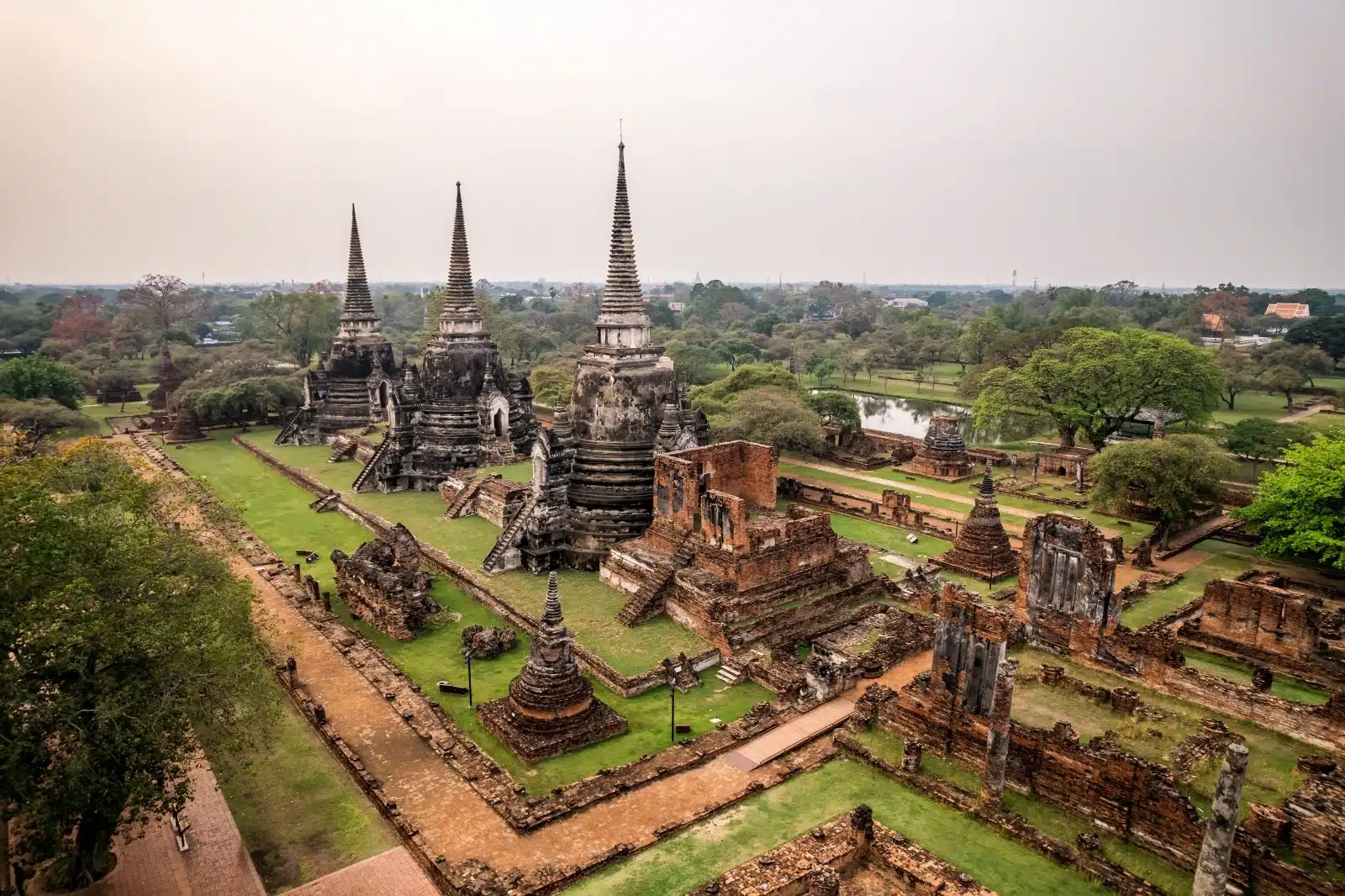
Image Credit: Shutterstock / RuslanKphoto
The ancient city of Ayutthaya, once the capital of the Kingdom of Siam, stands today as a UNESCO World Heritage Site, offering a journey through Thailand’s storied past. As you wander through the historical park, you’ll encounter the ruins of temples and palaces, each telling a tale of the city’s former glory and subsequent destruction. The site’s most iconic structures, such as Wat Mahathat and Wat Phra Si Sanphet, showcase the sophisticated art and architecture of the Ayutthaya period. Exploring Ayutthaya is not just a historical excursion; it’s an immersive experience that transports you back to when the city was a major trading hub of Asia. The juxtaposition of ancient ruins against a backdrop of modern life underscores the enduring legacy of Ayutthaya’s historical and cultural significance in Thailand.
Insider’s Tip
Visit during the early morning or late afternoon to avoid the heat and crowds.
How To Get There
Ayutthaya is a short train or bus ride from Bangkok.
Best Time To Travel
The cool season, from November to February, offers comfortable exploring conditions.
5. Krabi
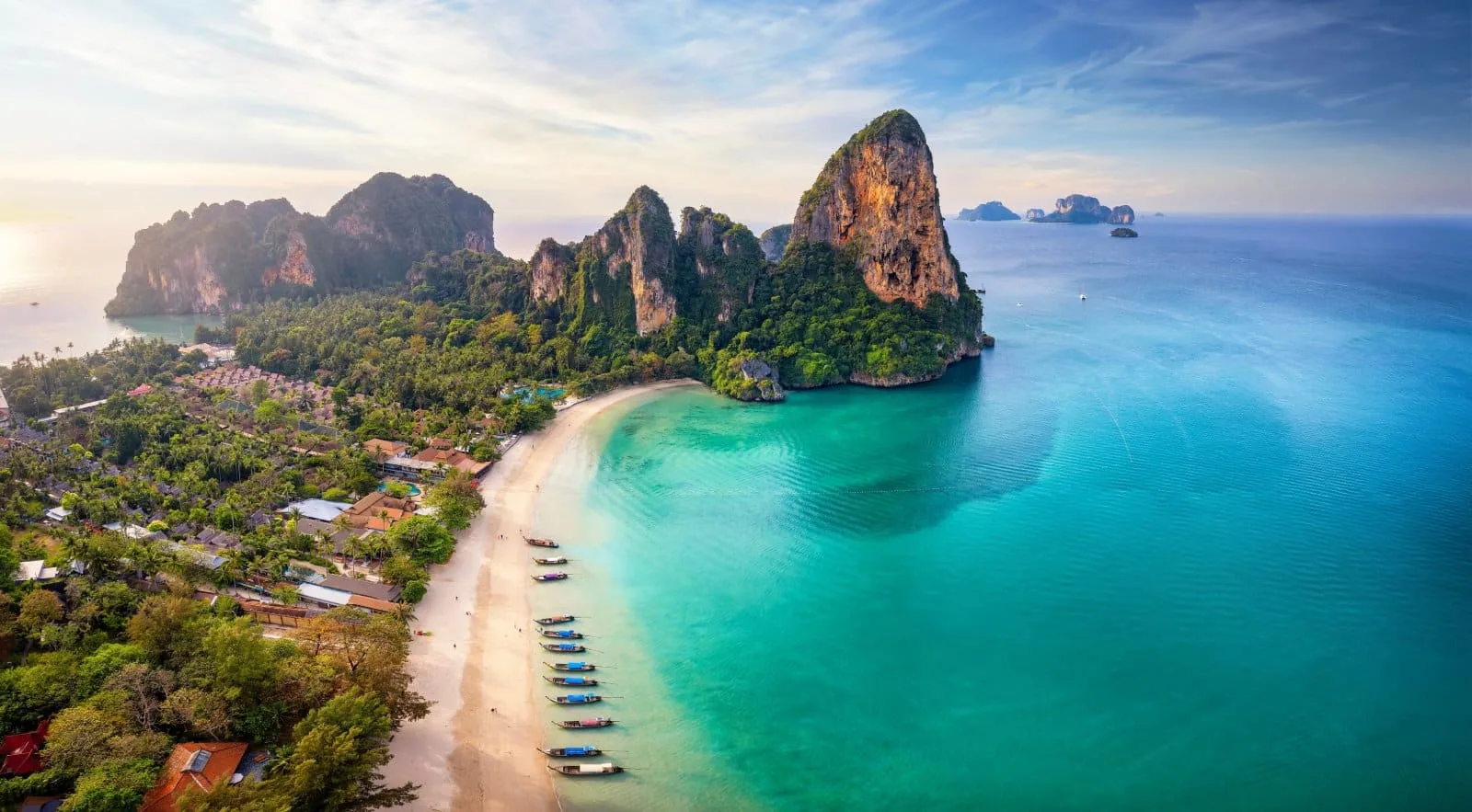
Image Credit: Shutterstock / Sven Hansche
In Krabi Province, you’ll find yourself amidst some of Thailand’s most picturesque landscapes, marked by dramatic limestone cliffs, pristine beaches, and clear blue waters. The province is renowned for destinations like Railay Beach, which is accessible only by boat. It offers world-class rock climbing and stunning beachscapes. The Phi Phi Islands, with their iconic beaches and vibrant marine life, are perfect for day trips, offering opportunities for snorkeling and diving. For a more tranquil experience, the lesser-known Koh Lanta provides a laid-back atmosphere with its long, sandy beaches. Krabi’s natural beauty extends beyond its coastline, with inland attractions like the Emerald Pool and the Tiger Cave Temple, each offering unique experiences. Whether you’re seeking adventure on the cliffs of Railay or tranquility on the beaches of Koh Lanta, Krabi presents a diverse array of natural wonders waiting to be explored.
Insider’s Tip
Explore the mangroves and limestone caves by kayak for a unique perspective.
How To Get There
Krabi has an airport, and it’s also accessible by bus and boat from other parts of Thailand.
Best Time To Travel
Visit from November to March for the best beach weather.
6. Pai
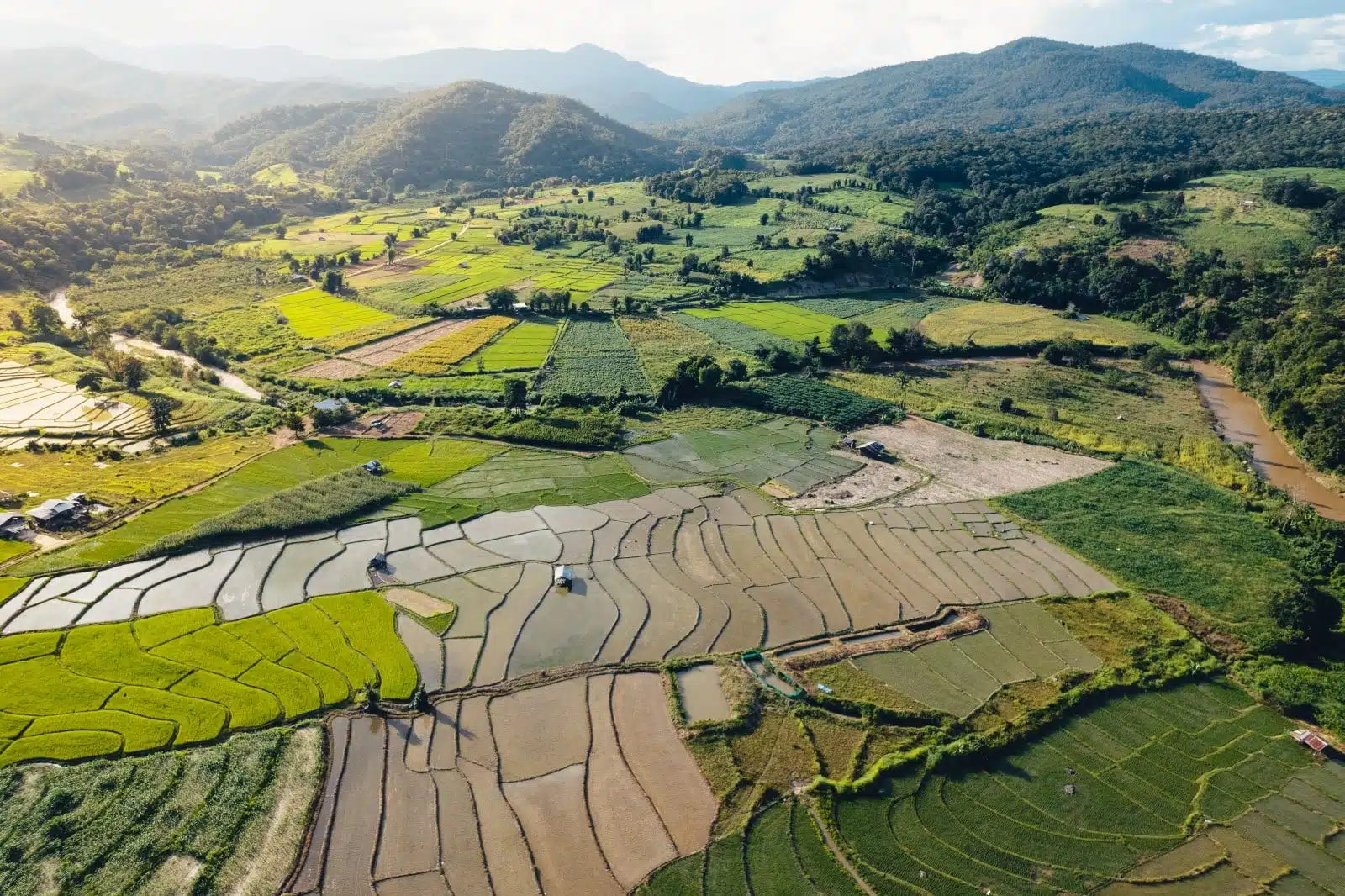
Image Credit: Shutterstock / RachenArt
Pai, nestled in the mountains of Northern Thailand, is a haven for those seeking tranquility and natural beauty. With its relaxed atmosphere, this small town attracts travelers looking to escape the hustle of city life. Surrounded by rolling hills and lush greenery, Pai is perfect for outdoor activities like hiking, visiting waterfalls, and exploring hot springs. The Pai Canyon offers stunning views, especially at sunset, and is a must-visit for nature enthusiasts. The town’s charming cafes, night markets, and art galleries reflect a unique blend of local Thai culture and bohemian influences. Renting a scooter to explore the surrounding countryside is a popular way to discover the area’s hidden gems, but be cautious on the winding roads. Pai’s natural beauty, laid-back vibe, and cultural richness make it a refreshing stop in your Thailand journey.
Insider’s Tip
Rent a scooter to explore the surrounding countryside, but be cautious on the winding roads.
How To Get There
Pai is accessible by bus from Chiang Mai.
Best Time To Travel
The cool season, particularly from October to February, is ideal for comfortable temperatures.
7. Sukhothai

Image Credit: Shutterstock / Tavarius
Sukhothai, the first capital of Thailand, is where Thai art, architecture, and language began to develop and flourish. The Sukhothai Historical Park, a UNESCO World Heritage Site, is an archaeological delight with well-preserved ruins and majestic Buddha statues set amidst scenic lakes and gardens. Exploring this ancient city on a bicycle offers a leisurely and intimate experience of the park’s vast grounds. Highlights include Wat Mahathat, with its impressive central stupa, and Wat Si Chum, known for its gigantic seated Buddha. The historical significance of Sukhothai, coupled with its serene and picturesque setting, provides a profound insight into the origins of Thai culture and the nation’s early history.
Insider’s Tip
Visit during the Loy Krathong festival in November, when the park is beautifully lit with lanterns.
How To Get There
Sukhothai is accessible by bus or plane from Bangkok and Chiang Mai.
Best Time To Travel
The cool season is the best time to visit, especially around the Loy Krathong festival.
8. Hua Hin
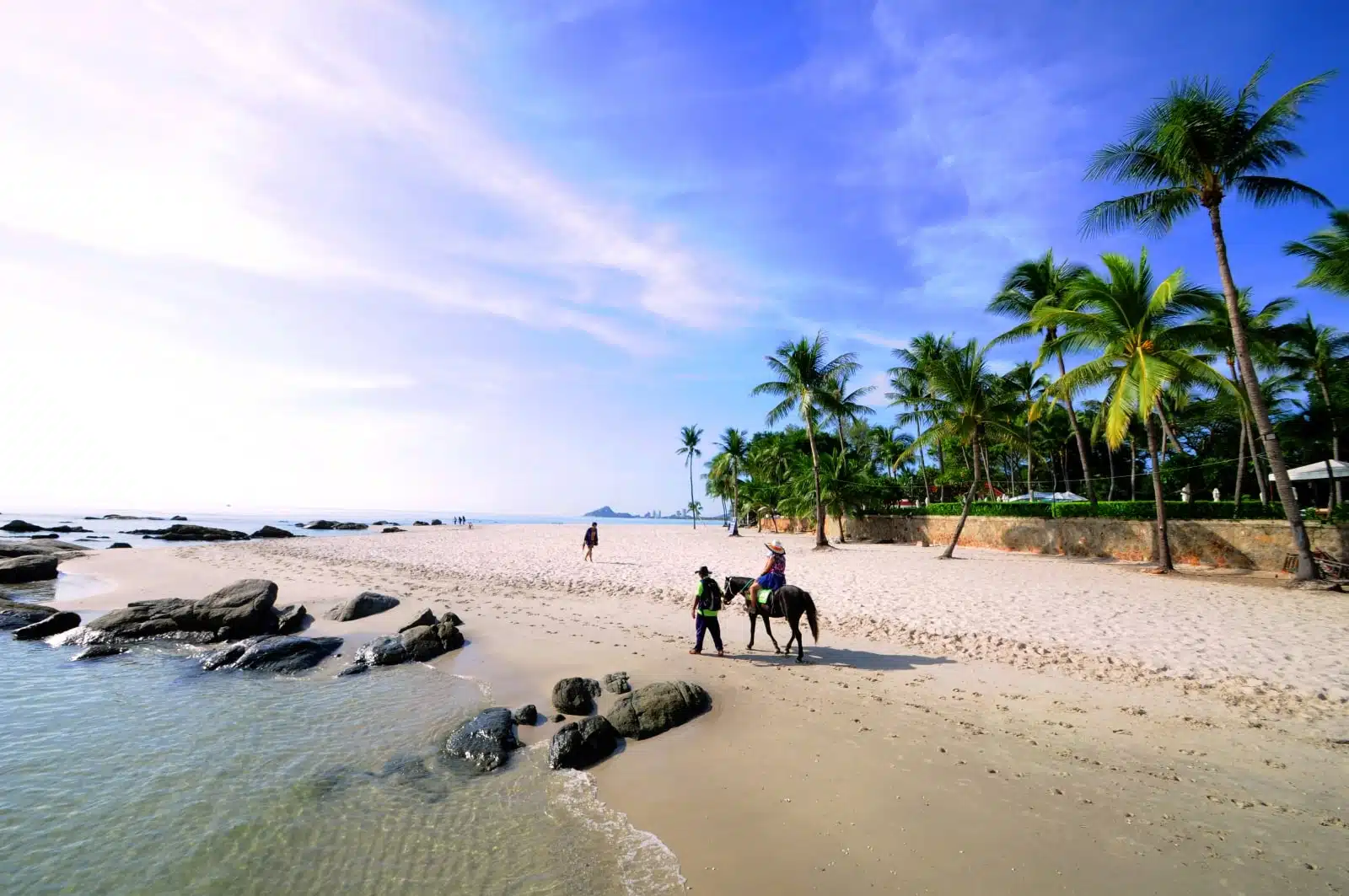
Image Credit: Shutterstock / Kaban-Sila
Hua Hin, once a quiet fishing village and now a popular beach resort town, offers a perfect blend of relaxation and cultural experiences. Known for its beautiful beaches, golf courses, and the summer palace of the Thai royal family, Hua Hin exudes an air of sophistication and tranquility. The night markets in Hua Hin, particularly the Cicada Market, are great for experiencing local crafts and cuisine. Nearby natural attractions like Sam Roi Yot National Park, with its limestone mountains and mangrove forests, provide opportunities for nature exploration. Hua Hin’s combination of beachside leisure, royal heritage, and natural beauty makes it an ideal destination for those seeking a more laid-back experience in Thailand.
Insider’s Tip
Try the local seafood at the night market, known for its freshness and variety.
How To Get There
Hua Hin is about a three-hour drive from Bangkok and is also accessible by train.
Best Time To Travel
Visit from November to February for the best beach weather and fewer rain showers.
9. Kanchanaburi
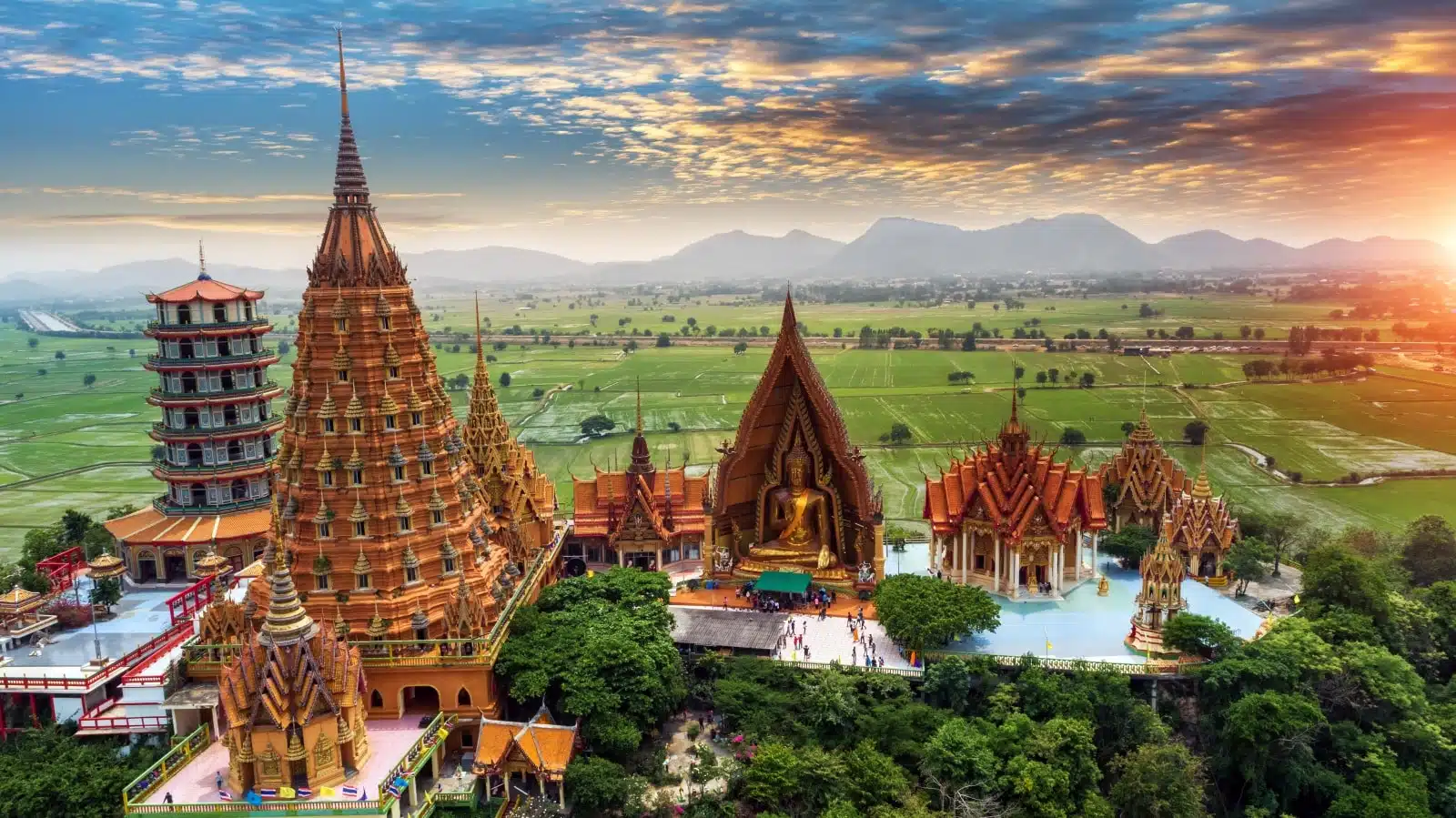
Image Credit: Shutterstock / Travel mania
Kanchanaburi, known for the Bridge over the River Kwai and its World War II history, offers a poignant reminder of the past, set against a backdrop of stunning natural scenery. The Death Railway, war cemeteries, and museums provide a deep understanding of the region’s wartime history. Beyond its historical significance, Kanchanaburi is also home to beautiful national parks like Erawan and Sai Yok, offering trekking, waterfalls, and river rafting. The province’s blend of history and natural beauty provides a multifaceted experience, making it a destination that appeals to history buffs and nature lovers.
Insider’s Tip
Take a train ride on the Death Railway for a scenic and historical journey.
How To Get There
Kanchanaburi is accessible by bus or train from Bangkok.
Best Time To Travel
The cool and dry season from November to February is ideal for exploring and outdoor activities.
10. The Golden Triangle
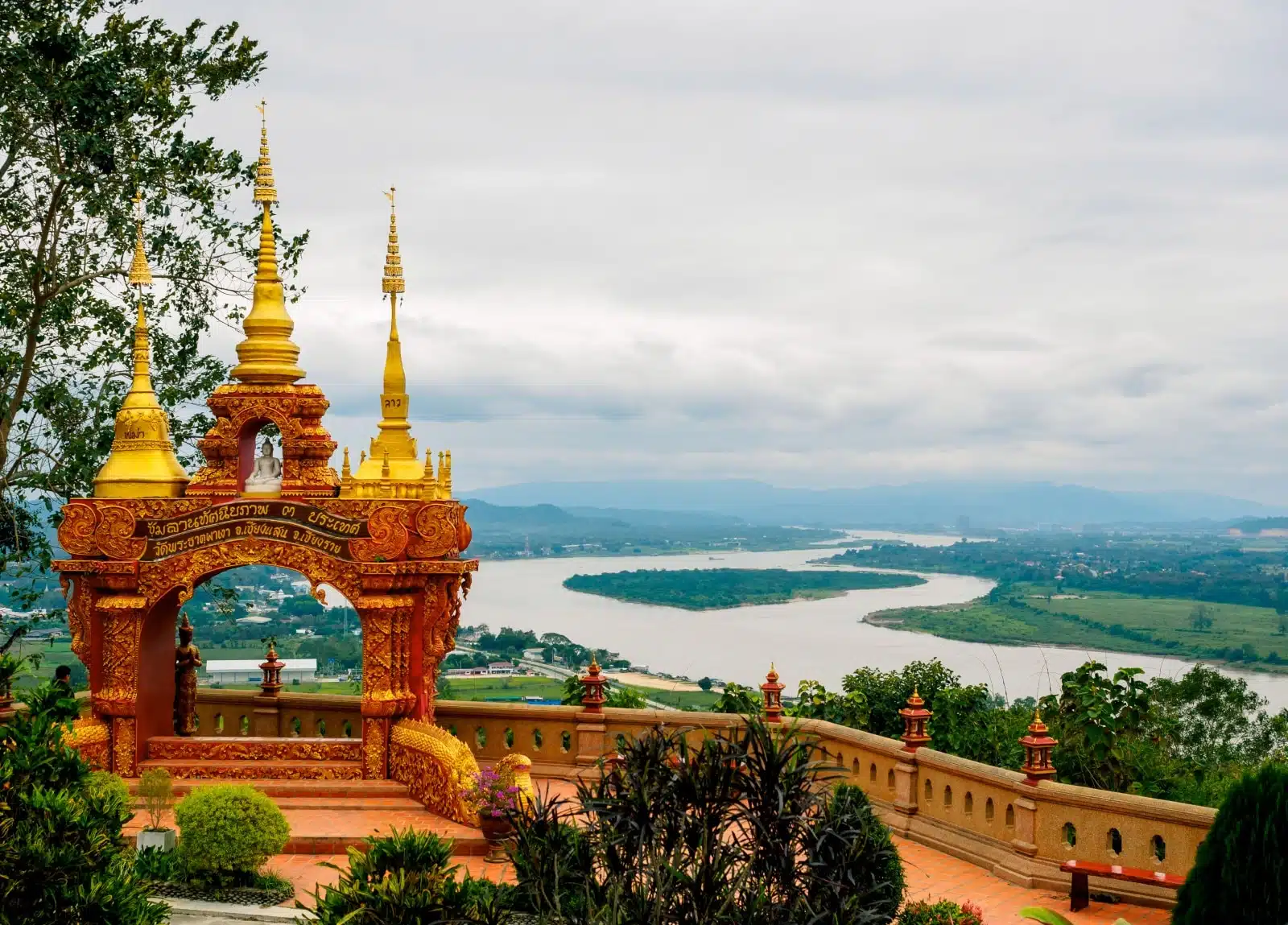
Image Credit: Shutterstock / Sompol
The Golden Triangle, where the borders of Thailand, Laos, and Myanmar converge, offers a unique cultural and geographical experience. This area, once notorious for its opium production, now provides insights into the region’s history with attractions like the Hall of Opium Museum. A boat ride on the Mekong River is a serene way to experience the beauty of this area and the confluence of the three countries. The ancient city of Chiang Saen nearby, with its ruins and temples, adds a historical dimension to your visit. The Golden Triangle’s cultural influences and stunning landscapes make it a fascinating destination in Northern Thailand.
Insider’s Tip
For a panoramic view of the three countries, visit the viewpoint at Wat Phra That Pu Khao.
How To Get There
The Golden Triangle is accessible by bus or car from Chiang Rai.
Best Time To Travel
The cool season, from November to February, offers comfortable weather for exploring.
11. Similan Islands
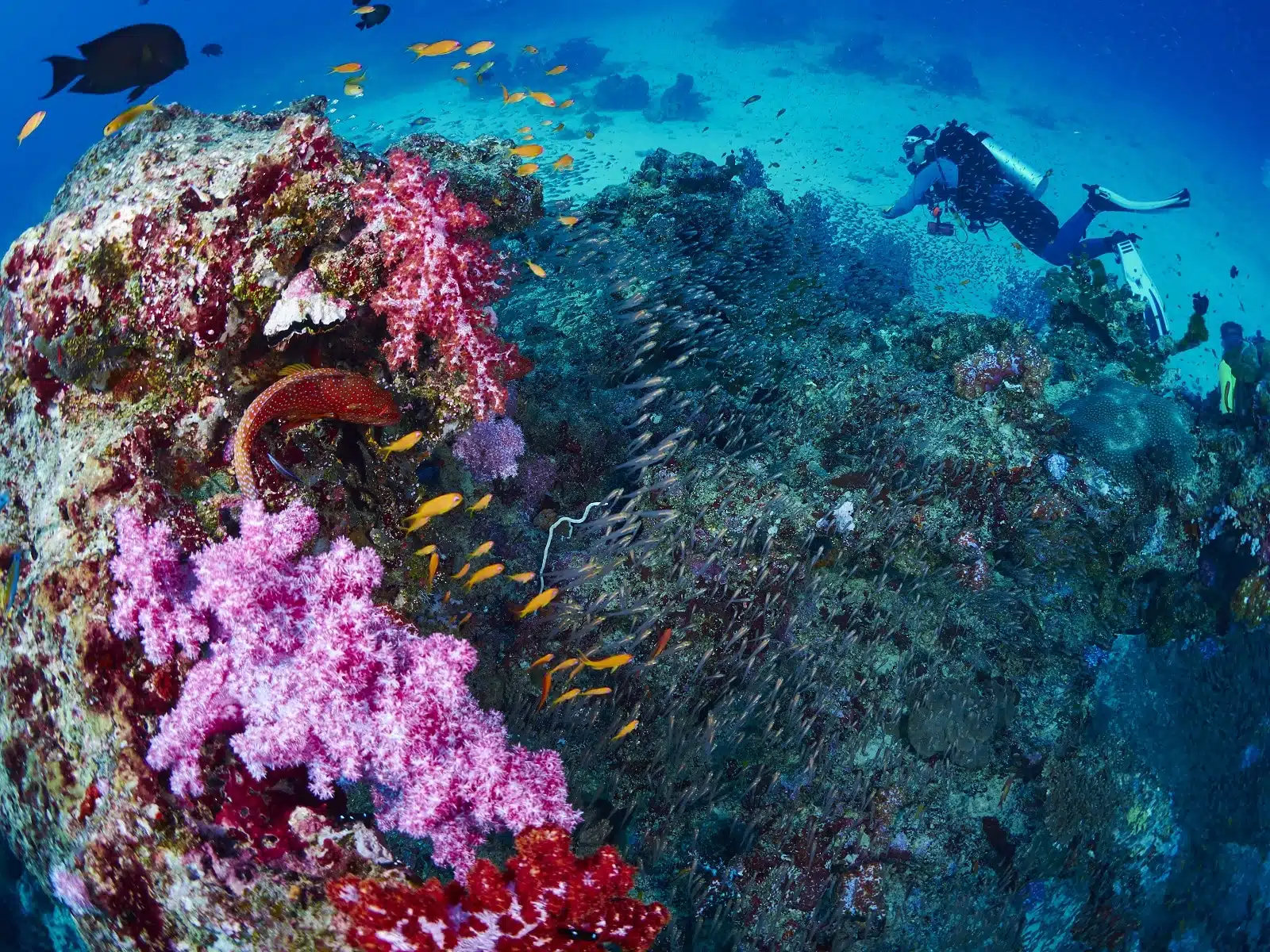
Image Credit: Shutterstock / metha1819
The Similan Islands in the Andaman Sea are a pristine archipelago renowned for their exceptional diving and snorkeling opportunities. These islands, part of a protected national park, boast some of the clearest waters in Thailand, with visibility often extending up to 30 meters. The underwater landscape of coral reefs teeming with diverse marine life, including manta rays, whale sharks, and a myriad of colorful fish species. Above water, the islands are equally stunning, with powdery white sand beaches and lush tropical forests. The Similan Islands are perfect for a retreat for anyone seeking unspoiled natural beauty. Whether you’re exploring the depths of the ocean or simply relaxing on a secluded beach, the Similans offer a tranquil escape from the world, where nature’s wonders are on full display.
Insider’s Tip
Book a liveaboard diving trip for an immersive experience in the islands’ underwater world.
How To Get There
The Similan Islands are accessible by boat from Khao Lak or Phuket.
Best Time To Travel
The diving season runs from November to April, with the best conditions from February to April.
12. The Isaan Region
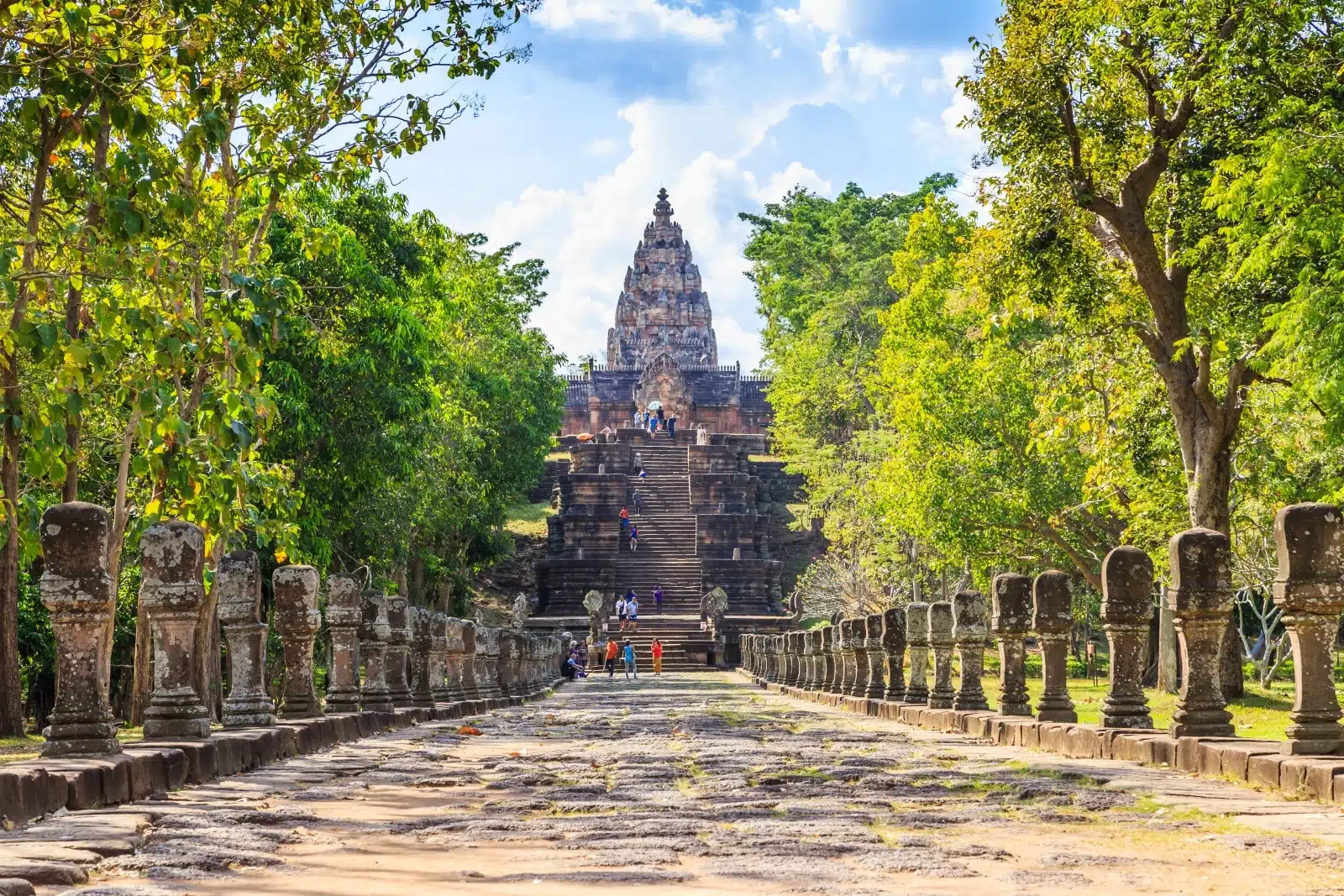
Image Credit: Shutterstock / Paahboobkk
The Isaan region, located in northeastern Thailand, is a land steeped in tradition and history, offering a stark contrast to the country’s more tourist-centric areas. This region is the heartland of Thai culture, where ancient customs and lifestyles are preserved. Isaan’s rural landscapes, dotted with rice paddies and traditional villages, provide a glimpse into a simpler way of life. The region is also home to some of Thailand’s most significant archaeological sites, including the prehistoric Ban Chiang and the Khmer ruins of Phanom Rung. Isaan’s cuisine, known for its bold flavors and spiciness, is a highlight, with dishes like som tam (spicy papaya salad) and larb (minced meat salad) being local staples. A journey through Isaan is a journey through the soul of Thailand, where the richness of the country’s heritage and the warmth of its people are palpable in every experience.
Insider’s Tip
Try the local dishes like som tam (spicy papaya salad) and larb (minced meat salad) for an authentic taste of Isaan.
How To Get There
Isaan is accessible by bus or train from Bangkok, or by plane to regional airports like Udon Thani.
Best Time To Travel
Visit during the cool season, from November to February, for comfortable travel conditions.
13. Koh Samui

Image Credit: Shutterstock / Muzhik
Koh Samui, nestled in the Gulf of Thailand, is a tropical paradise combining natural beauty, luxury, and relaxation. The island is renowned for its idyllic beaches, such as Chaweng and Lamai, which offer crystal-clear waters and powdery white sands. Beyond its stunning coastline, Koh Samui has various attractions, from the majestic Big Buddha statue to the enchanting Na Muang Waterfalls. The island’s interior is a lush landscape of coconut groves and rainforests, offering opportunities for hiking and exploring. Koh Samui’s culinary scene is a blend of traditional Thai flavors and international cuisine, with a plethora of dining options ranging from beachside shacks to upscale restaurants. The island’s vibrant nightlife, centered around Chaweng Beach, provides entertainment well into the early hours. Koh Samui caters to all types of travelers seeking a romantic getaway, a family vacation, or a luxurious retreat.
Insider’s Tip
Explore the Ang Thong National Marine Park for stunning landscapes and snorkeling opportunities.
How To Get There
Koh Samui has an airport with flights from Bangkok, Chiang Mai, and international destinations.
Best Time To Travel
The best time to visit is from December to February, with dry weather and calm seas.
14. Railay Beach
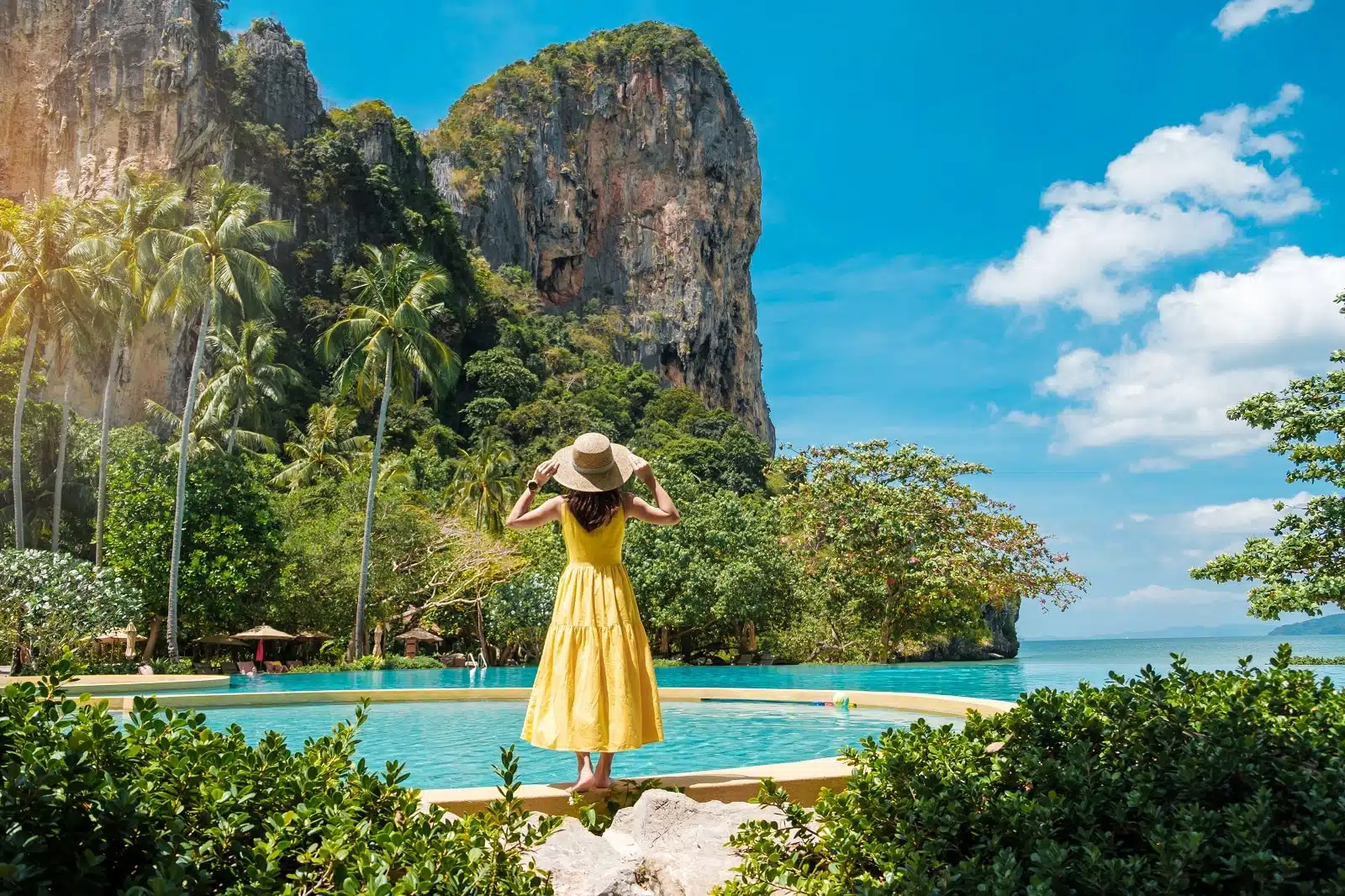
Image Credit: Shutterstock / Jo Panuwat D
Railay Beach, accessible only by boat, is a hidden gem offering a serene escape from the more crowded tourist spots. This peninsula, known for its stunning limestone cliffs and pristine beaches, is a haven for rock climbers and beachgoers. The turquoise waters are perfect for swimming and kayaking, while the viewpoints and caves provide opportunities for exploration. Railay maintains a laid-back atmosphere, with a small selection of bars and restaurants, making it an ideal spot for adventure and relaxation in a tranquil setting.
Insider’s Tip
Take a rock climbing course if you’re a beginner to safely enjoy the sport under expert guidance.
How To Get There
Railay Beach is accessible by boat from Ao Nang or Krabi Town.
Best Time To Travel
Visit from November to April when the weather is dry, and the seas are calm.
15. Udon Thani and the Red Lotus Sea
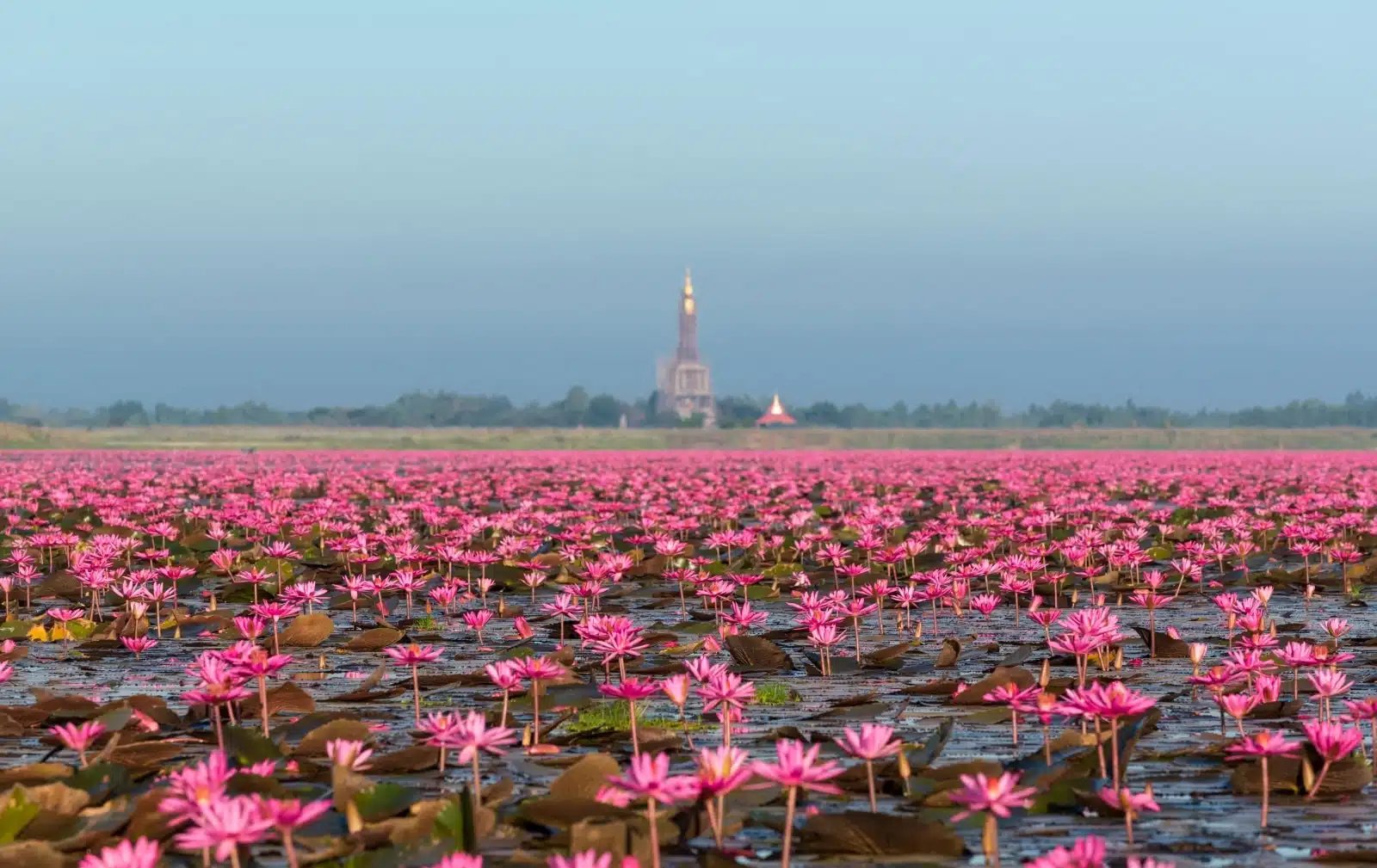
Image Credit: Shutterstock / tphatrapornnant
Udon Thani, a vibrant city in Thailand’s northeastern region, is the gateway to the mesmerizing Red Lotus Sea (Lake Nong Han). It’s best visited in the cool season, as it transforms into a breathtaking expanse of pink and red lotuses stretching as far as the eye can see. A boat ride through the serene waters, dotted with these vibrant blooms, offers a truly unique and tranquil experience. Beyond the lake, Udon Thani boasts a rich cultural heritage, with various temples, museums, and markets reflecting the local Isan culture. The Ban Chiang Archaeological Site, a UNESCO World Heritage Site near Udon Thani, provides fascinating insights into the region’s ancient history. This area’s blend of natural beauty and cultural depth makes it a compelling destination for those exploring beyond Thailand’s typical tourist paths.
Insider’s Tip
Visit early in the morning when the lotuses are fully bloomed and the lake is less crowded.
How To Get There
Udon Thani is accessible by plane from Bangkok, and the Red Lotus Sea is a short drive from the city.
Best Time To Travel
The lotuses bloom from December to February, making it the ideal time to visit.
16. The Ancient City of Sukhothai

Image Credit: Shutterstock / Sergii Figurnyi
The ancient city of Sukhothai, a UNESCO World Heritage Site, is a journey back in time to the roots of Thai civilization. As the first capital of Thailand, it holds a special place in the nation’s history. The Sukhothai Historical Park, with its well-preserved ruins set amidst lush greenery and tranquil ponds, offers a glimpse into the grandeur of the 13th-century Sukhothai Kingdom. Exploring the park, you’ll encounter majestic Buddha figures, towering stupas, and intricate carvings, all evocative of the city’s past splendor. Cycling through the park’s vast grounds allows for an intimate exploration of its numerous sites, including Wat Mahathat, the park’s largest temple, and Wat Si Chum, famous for its gigantic seated Buddha. A visit to Sukhothai immerses ancient Thailand’s artistic and spiritual legacy.
Insider’s Tip
Rent a bicycle to explore the extensive grounds of the historical park at your own pace.
How To Get There
Sukhothai is accessible by bus or plane from Bangkok, and the historical park is a short ride from the city center.
Best Time To Travel
The cool season from November to February offers pleasant weather for exploring the outdoor ruins.
17. The Floating Markets Near Bangkok
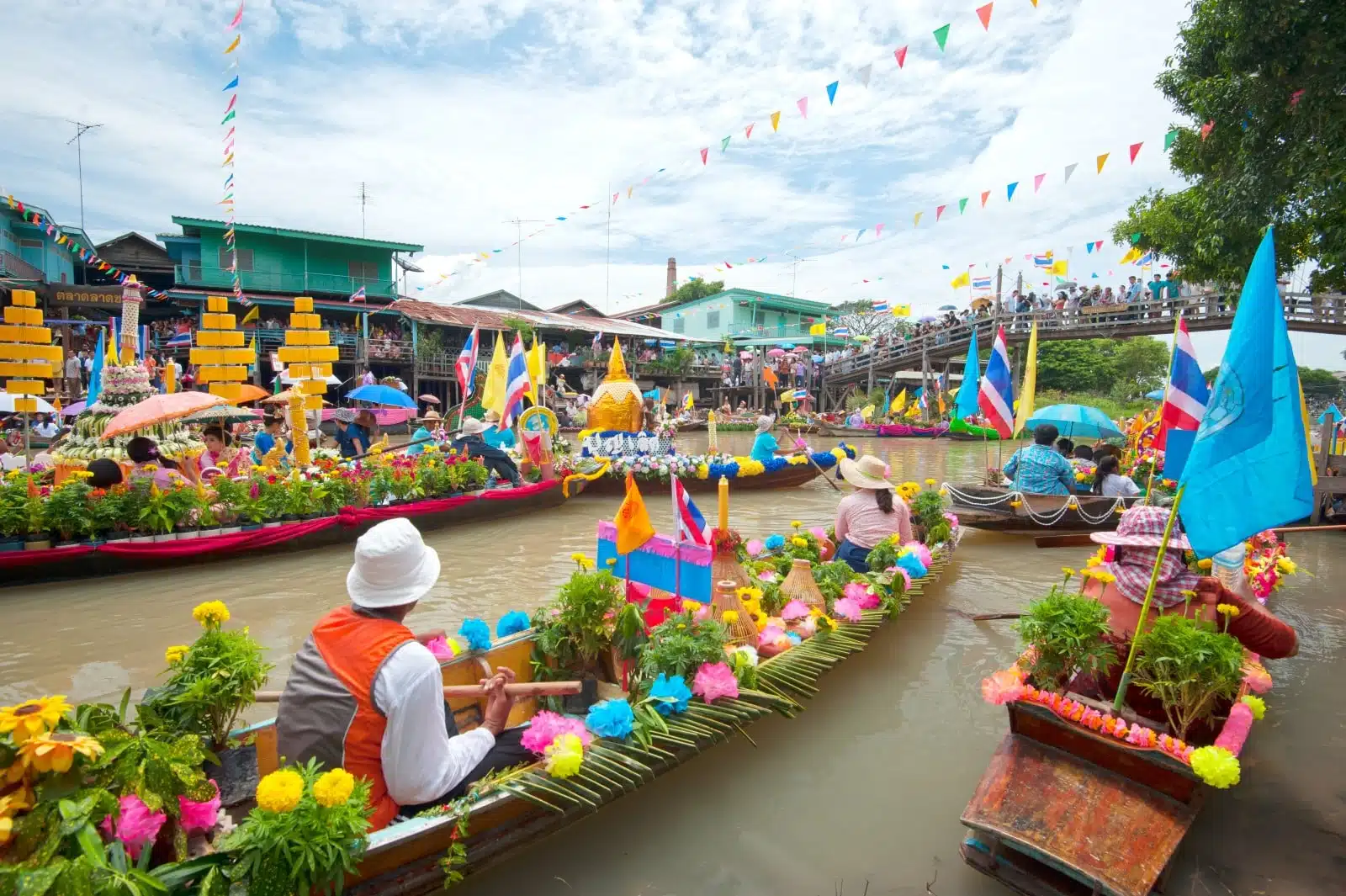
Image Credit: Shutterstock / nimon
The floating markets near Bangkok, such as Damnoen Saduak and Amphawa, offer a vibrant and colorful glimpse into traditional Thai life. These bustling waterways, lined with boats laden with fresh produce, local delicacies, and handicrafts, present a lively and picturesque scene. A visit to these markets is a sensory experience, with the sights, sounds, and smells of authentic Thai commerce and cuisine. Damnoen Saduak, the most famous of these markets, provides a more tourist-focused experience, while Amphawa offers a more local atmosphere and is primarily known for its evening seafood vendors. Exploring these floating markets by boat or along the canalside walkways is a unique way to experience the local culture and indulge in some of Thailand’s most delicious foods and charming souvenirs.
Insider’s Tip
Take a boat tour to fully experience the market and try local snacks from the floating vendors.
How To Get There
The floating markets are accessible by bus or organized tours from Bangkok.
Best Time To Travel
Visit early in the morning to avoid the crowds and the heat.
18. Erawan National Park and Waterfalls
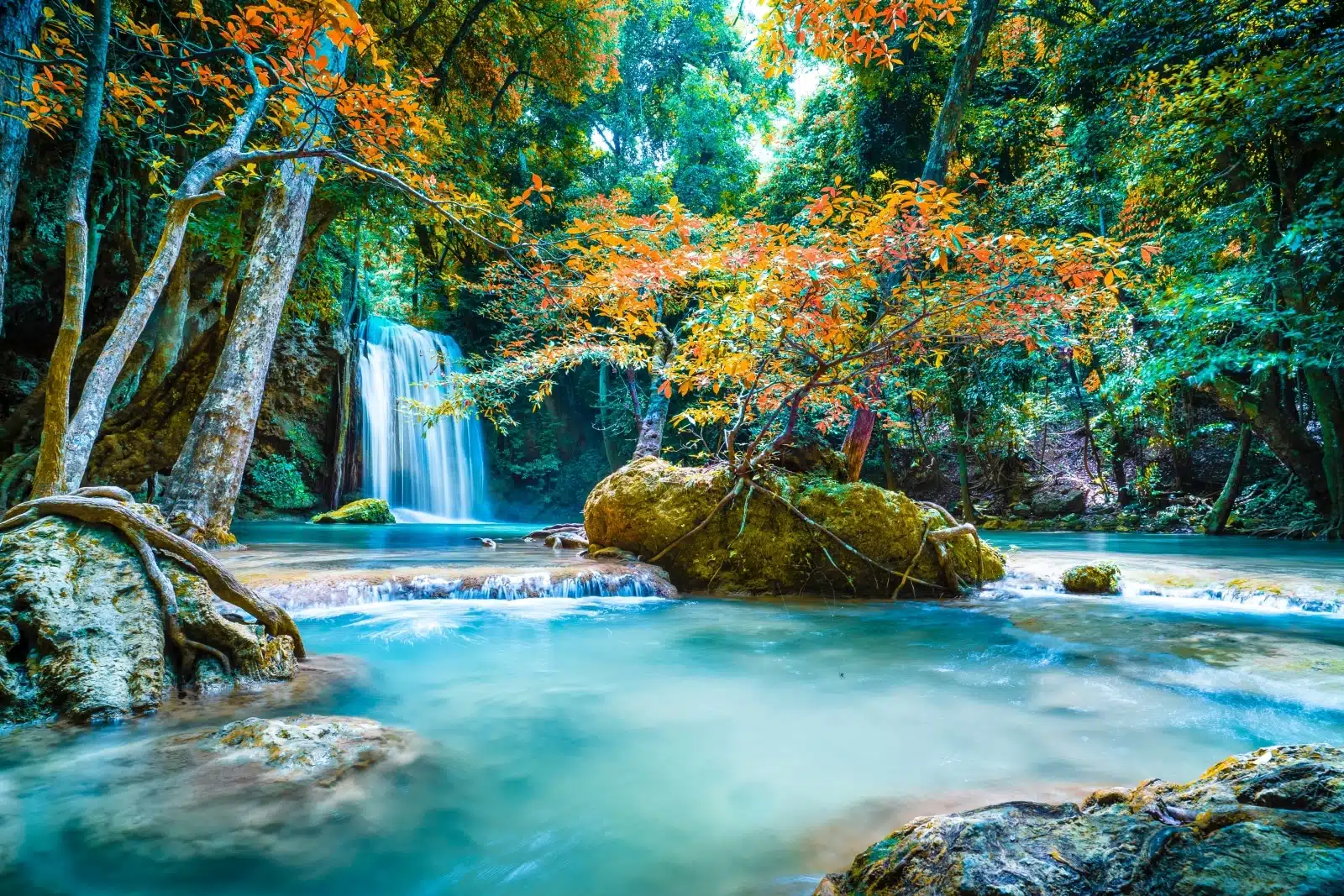
Image Credit: Shutterstock / Dpongvit
Erawan National Park, located in the Kanchanaburi Province, is a natural oasis known for its stunning seven-tiered Erawan Waterfall, named after the three-headed elephant of Hindu mythology. Each tier of the waterfall offers a different shape and character, with natural pools perfect for swimming and relaxation. The park’s lush forests are home to plentiful wildlife and provide numerous hiking trails for nature enthusiasts. Beyond the waterfalls, the park’s caves, such as Tham Phra That and Tham Ta Duang, offer further exploration opportunities. Visiting Erawan National Park is a chance to witness one of Thailand’s most beautiful waterfalls and connect with the country’s rich natural landscapes.
Insider’s Tip
Bring swimwear and trek to the upper tiers of the waterfall for a more secluded and serene experience.
How To Get There
The park is located in Kanchanaburi Province and is accessible by bus or car from Bangkok.
Best Time To Travel
Visit from November to April when the water levels are ideal for swimming and the trails are dry.
19. Pattaya
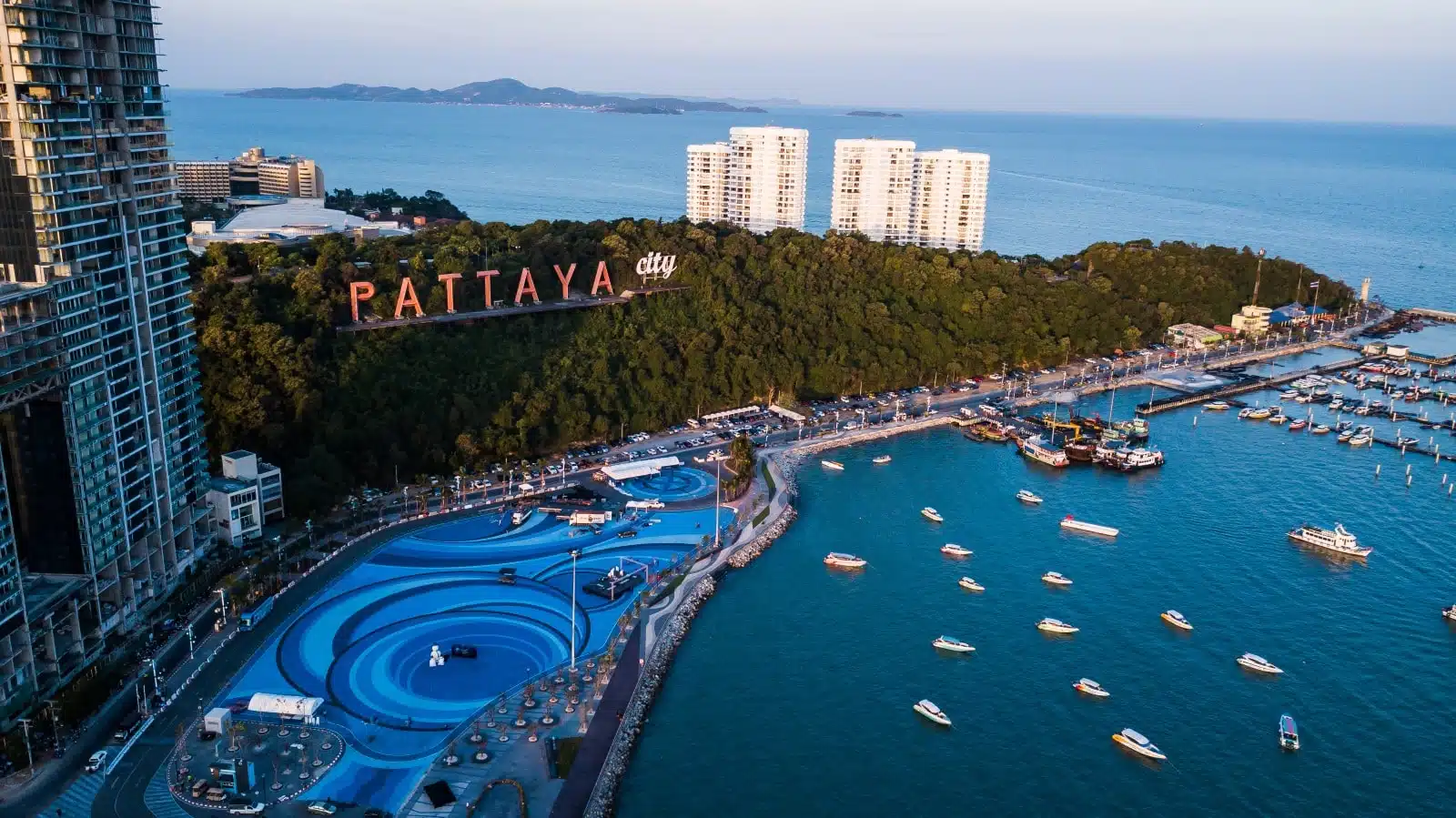
Image Credit: Shutterstock / kamomeen
Pattaya, once a quiet fishing village and now a bustling coastal city, is known for its vibrant nightlife, sandy beaches, and many tourist attractions. While Pattaya’s reputation is often tied to its entertainment and nightlife, the city offers much more. The Sanctuary of Truth, a stunning all-wood structure filled with intricate carvings, highlights traditional Thai craftsmanship. For nature lovers, Pattaya offers the Nong Nooch Tropical Botanical Garden, a beautifully landscaped park with themed gardens and cultural shows. The nearby Coral Island (Koh Larn) provides a quick escape to quieter beaches and clear waters, ideal for snorkeling and water sports. Pattaya’s diverse offerings make it a destination that caters to various interests, from cultural exploration to beachside relaxation.
Insider’s Tip
Explore the Pattaya Floating Market for a cultural experience and to sample local Thai dishes.
How To Get There
Pattaya is a two-hour drive from Bangkok and is also accessible by bus or taxi.
Best Time To Travel
Visit from November to February for pleasant weather and to avoid the rainy season.
20. The Hill Tribes of Northern Thailand
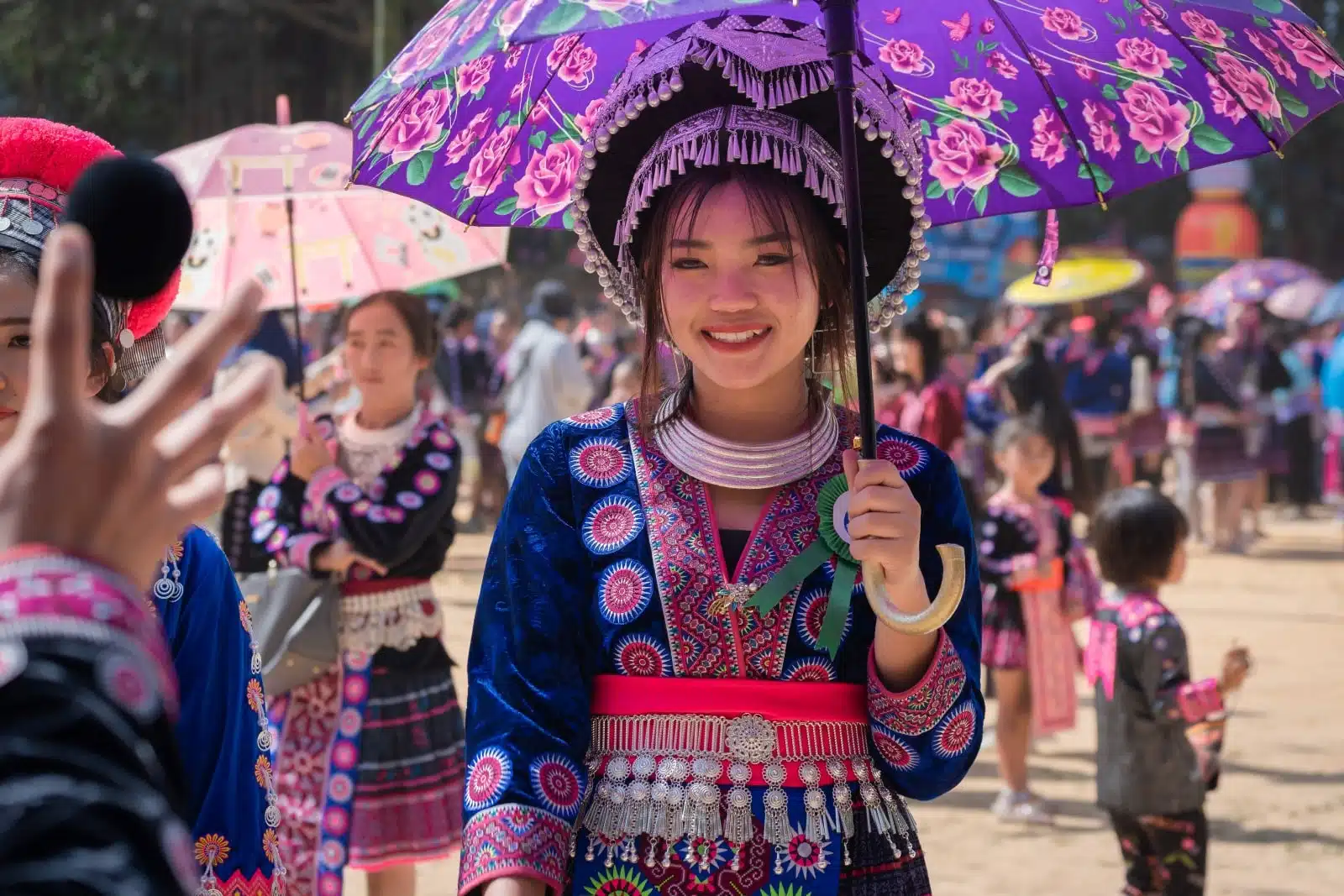
Image Credit: Shutterstock / Supermop
Northern Thailand’s hill tribes offer a unique cultural experience, distinct from the rest of the country. These ethnic groups, including the Karen, Hmong, Akha, and Lisu, each have their own customs, languages, and traditional dress. Visiting these hill tribe villages, often nestled in the picturesque mountains and valleys of the region, provides insight into their traditional ways of life, which remain largely untouched by modernization. Responsible and respectful tourism is key when visiting these communities. Many villages welcome visitors to learn about their culture, participate in traditional crafts, and even stay overnight for a more immersive experience. Engaging with the hill tribes of Northern Thailand offers a deeper understanding of the country’s ethnic diversity and rich cultural tapestry.
Insider’s Tip
Choose a community-based tourism program that benefits the tribes directly and respects their culture.
How To Get There
Hill tribe villages are accessible from Chiang Mai or Chiang Rai, often as part of guided tours.
Best Time To Travel
The cool season, from November to February, is comfortable for visiting the highland areas.
The Bottom Line
Thailand’s magic lies in its diversity – from bustling cities and ancient ruins to serene beaches and lush jungles. As you explore this enchanting country, embrace its history, indulge in its culinary delights, and immerse yourself in its natural beauty. Remember, Thailand offers an experience beyond the ordinary, leaving you with memories that will last a lifetime.
While exploring Thailand, take the time to learn a few phrases in Thai. A simple “hello” (sawasdee) or “thank you” (khob khun) can go a long way in showing respect for the local culture and enhancing your travel experience.
More From The Green Voyage
Top 10 Trending Travel Destinations 2024
6 Essential Banking Apps for International Travel – Managing Your Finances on the Go
Traveling With Kids – 10 Tips to Create Memorable Family Holidays
The post 20 Places To Visit in Thailand 2024 first appeared on The Green Voyage.
Featured Image Credit: Shutterstock / Pikoso.kz.
For transparency, this content was partly developed with AI assistance and carefully curated by an experienced editor to be informative and ensure accuracy.
Tips for Trip Success
Book Your Flight
Find an inexpensive flight by using Kayak, a favorite of ours because it regularly returns less expensive flight options from a variety of airlines.
Book Your Hotel or Special Accommodation
We are big fans of Booking.com. We like their review system and photos. If we want to see more reviews and additional booking options, we go to Expedia.
You Need Travel Insurance!
Good travel insurance means having total peace of mind. Travel insurance protects you when your medical insurance often will not and better than what you get from your credit card. It will provide comprehensive coverage should you need medical treatment or return to the United States, compensation for trip interruption, baggage loss, and other situations.Find the Perfect Insurance Plan for Your Trip
